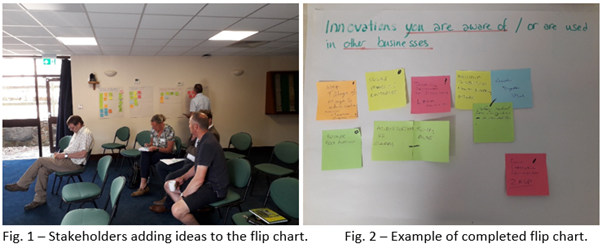Zoe Barker
Project Partners in the UK have been working with a wide range of dairy industry stakeholders to understand how the industry is innovating to achieve climate change objectives and identify innovations that can be adopted to reduce the carbon footprint of the industry. They have also been discussing these innovations with consumers to better understand their views on the current and potential future innovations.
Four industry stakeholder meetings were undertaken in the summer of 2022. These took place in the south and the midlands of the UK. Participants included farmers, farm advisors and consultancy services, medium scale processors of premium dairy products, large scale milk processors, farm knowledge exchange organisations, and certification bodies.

The project team used a participatory approach to collect information on ‘the current innovations’ that were either being implemented by the attendees or that they were aware of others using within their sector of the cain supply. In addition, attendees were asked which innovations they hoped to see in the near future. At each meeting the innovations were scored by the group on a range of factors such as ease and cost of implementation, effectivity to mitigate climate change, impacts on productivity and appeal to the consumer. From these discussions the following list of innovative solutions to climate change were taken forward to a series of consumer focus groups.
- Reducing energy usage (e.g. heat recovery, renewables, more efficient processing)
- Reduced use of inputs with high Carbon footprints (e.g. artificial fertilisers, imported soya)
- Waste management (e.g. slurry additives, methane capture from slurry)
- Improving soil health (e.g. reduced soil disturbance, herbal leys)
- Reducing the methane emitted by cows (e.g. feed additives, methane capture)
- Increased grazing area
- Agroforestry/silvopasture
- Animal management (e.g. genomic selection, sexed semen, precision livestock technologies)
The dairy products consumed by the participants in the consumer workshops varied and included preferences for both conventional and organic production systems, for low-fat and full-fat options, and for opting for some or all dairy alternatives. Drivers for these choices included food safety and nutritional value, health concerns, taste, packaging type, product lifespan, and storage. The above climate smart innovations were presented to the consumers with a short explanation as to how they worked, the likely effectiveness, and how they were implemented by farmers. Overall, they were viewed positively by consumers although some consumers identified potential barriers to uptake or expressed a view that the innovation may have limited impact on the significant issue of climate change. However, the methane capture innovations presented did elicit stronger and divided opinions. Some people were intrigued and excited about the potential benefits, while others expressed concerns that animal welfare would be negatively affected by the methane capture solutions or that food safety would be compromised by methane reducing feed additives. Feedback from these focus groups will now be used to design a consumer choice experiment that will quantify the value consumers place on different innovations through their purchasing choices and willingness to pay.
Leave a Reply